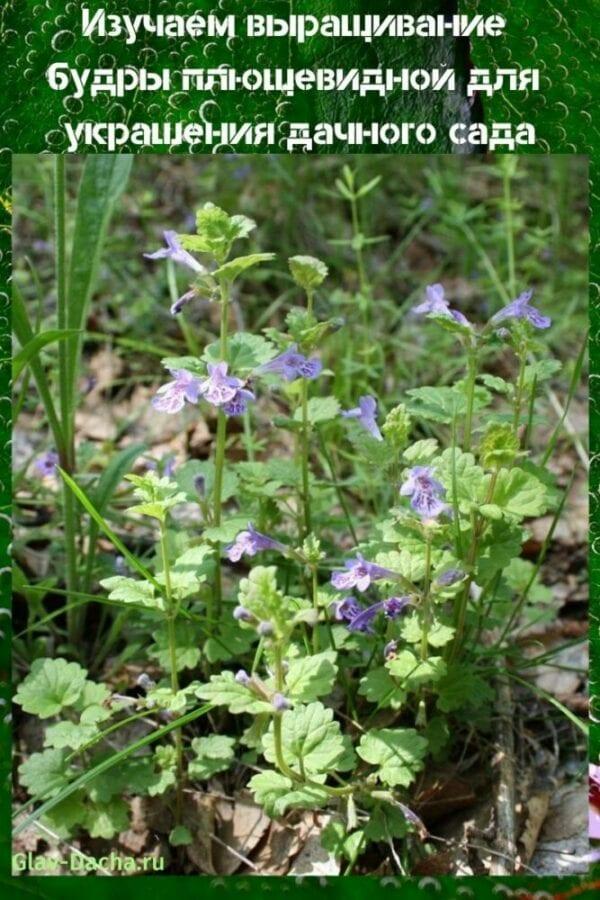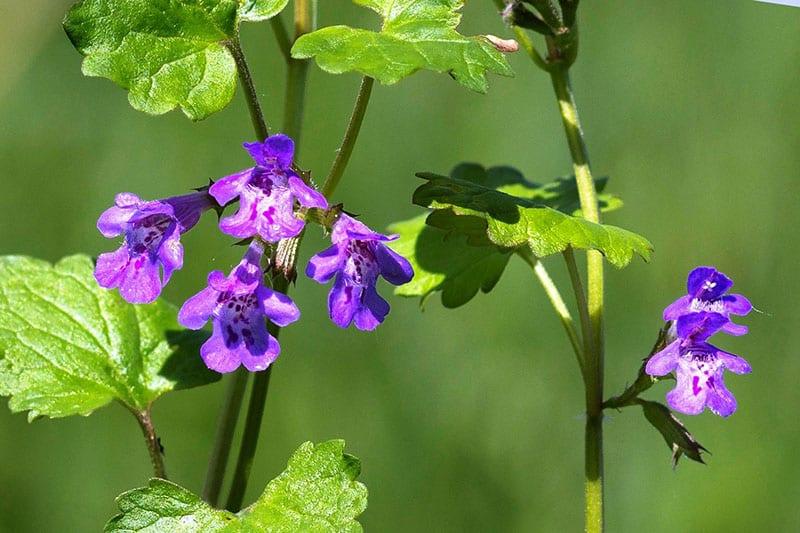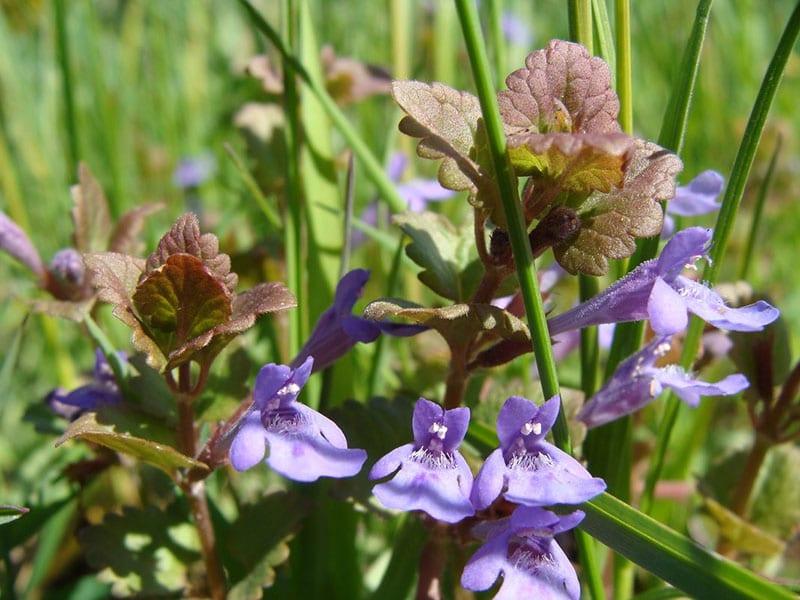We study the cultivation of ivy budra to decorate the country garden
 Ivy budra is an evergreen plant that is often used as an ornamental groundcover in a summer cottage. Growing ivy budra helps not only to decorate the garden, but also to protect the flower beds from excessive drying out and weed growth.
Ivy budra is an evergreen plant that is often used as an ornamental groundcover in a summer cottage. Growing ivy budra helps not only to decorate the garden, but also to protect the flower beds from excessive drying out and weed growth.
Botanical description of ivy budra

The main features of ivy budra:
- Plant height is 40-70 cm. The branches are erect.
- Stems are thin, tetrahedral, creeping along the ground in green, greenish-white or crimson color.
- The leaves are small in size, heart-shaped, with wavy edges. The foliage is located on petioles, placed in pairs on the stem.
- A perennial plant blooms in May, flowering lasts until about August. Ivy budra has small flowers of a purple-lilac or blue hue.
- After the end of flowering, fruits ripen on the plant - small seed pods of brown color.
 When growing budr, ivy is most often used as an ornamental soil-covering plant, unpretentious in care and resistant to various diseases. Also, budra can be a great element when creating rockery.
When growing budr, ivy is most often used as an ornamental soil-covering plant, unpretentious in care and resistant to various diseases. Also, budra can be a great element when creating rockery.
Plant species

In nature, there are about 10 varieties of Budra, each of which has its own botanical characteristics:
- Ivy budra is a plant up to 40 cm high with a pleasant mint aroma. Stems are slightly raised above the ground, with numerous branches and rounded or kidney-shaped leaves on short petioles. The flowers are lilac-blue.
- Common budra is a perennial, reaching 30-40 cm in height. Has creeping stems and rising, flowering shoots. Leaves are reniform or heart-shaped, inflorescences can be white, scarlet, lilac-blue or purple.
- Variegated budra is an ornamental plant that forms low "carpets" up to 10-20 cm high. Creeping stems with numerous branches.
Variegated budra is widely used in the field of landscape design. This plant is used for decorating front gardens, stony and wooden compositions.
Growing ivy budra

When growing ivy buddha in a garden plot, several rules must be observed to ensure the active growth of the plant:
- Perennial does not impose any requirements on the composition of the soil, so it can be grown in almost any area. When grown at home, a substrate is prepared for Budra from leafy and soddy soil, humus and sand.
- Ivy budra is very fond of sunlight. The plant should be illuminated for at least 15-17 hours a day - but the light should be diffused, direct sunlight can cause plant burns.
- You can start planting ivy budra only after the air temperature is at least + 10 ° C outside, and the soil warms up evenly.
When growing budra outdoors, it is best to choose areas that are evenly lit and in direct sunlight for most of the day.
Ivy buddha can be grown at home by placing a pot with a plant on a windowsill on the south, southwest, or southeast side. On summer days, the flower must be taken out into the fresh air, not forgetting to shade it from direct sunlight.
Planting ivy budra
 Planting ivy budra in the open field is carried out both by seeds and cuttings. This plant belongs to wild-growing crops, therefore it takes root well with any method of planting.
Planting ivy budra in the open field is carried out both by seeds and cuttings. This plant belongs to wild-growing crops, therefore it takes root well with any method of planting.
Sowing seeds of ivy budra can be carried out both in early spring and in autumn - this plant is distinguished by good winter hardiness, therefore, it easily tolerates frosts.
Planting perennial seeds:
- loosen the area;
- remove weeds;
- moisten the soil;
- sow seeds in random order;
- sprinkle with a small amount of earth, slightly compacting it;
- water the beds twice a week before sprouting.
Planting ivy budra can be done with cuttings. To obtain them, it is necessary to separate from an adult plant several shoots up to 10-15 cm long without inflorescences.
Planting material should be placed in wet sand, peat-sand mixture or clean water. As soon as the roots grow on the cuttings, they can be transplanted into open soil.
Caring for ivy budra after planting
Ivy budra refers to unpretentious plants that do not require special care. He requires standard agricultural procedures - moderate watering, top dressing and timely pruning.
Watering
 Ivy budra does not tolerate prolonged drought well, therefore, the soil in the flower bed should not be allowed to dry out. In summer, the plant should be watered at least 2 times a week. Abundant watering is required from April-May to September. After that, the amount of watering is reduced, and temporarily stops in winter.
Ivy budra does not tolerate prolonged drought well, therefore, the soil in the flower bed should not be allowed to dry out. In summer, the plant should be watered at least 2 times a week. Abundant watering is required from April-May to September. After that, the amount of watering is reduced, and temporarily stops in winter.
Good growth and full development of ivy budra are only possible with sufficient soil moisture.
To maintain an optimal moisture level, perennial foliage needs to be sprayed from time to time from a spray bottle.
Top dressing
 In March-April, the plant “wakes up” after winter dormancy and the phase of active growth begins. From this time until the end of August or the beginning of September, ivy budra needs additional feeding. It is best to use complex mineral fertilizers, applying them once every 4 weeks.
In March-April, the plant “wakes up” after winter dormancy and the phase of active growth begins. From this time until the end of August or the beginning of September, ivy budra needs additional feeding. It is best to use complex mineral fertilizers, applying them once every 4 weeks.
Transplant and pruning
 Ivy budra does not need frequent transplants, so this procedure should be carried out only as needed. It is best to replant a perennial plant in April or May, when a stable warm air temperature is established.
Ivy budra does not need frequent transplants, so this procedure should be carried out only as needed. It is best to replant a perennial plant in April or May, when a stable warm air temperature is established.
To form a beautiful and neat bush, ivy-shaped budra is trimmed. The optimal time for pruning is March or April, before the plant begins to actively grow. During pruning, all diseased, dried out shoots are removed. You can also cut some healthy branches and use them as cuttings for planting.
Diseases and pests
 Ivy budra is distinguished by good resistance to diseases and pests. This plant may suffer from root rot caused by prolonged exposure to direct sunlight or excess moisture in the soil. Rot can be determined by yellowing and falling foliage.
Ivy budra is distinguished by good resistance to diseases and pests. This plant may suffer from root rot caused by prolonged exposure to direct sunlight or excess moisture in the soil. Rot can be determined by yellowing and falling foliage.
Also, a perennial can be affected by spider mites - the main reason for the appearance of the pest is considered to be insufficient moisture in the ivy budra. Also, the flower can attack whiteflies and aphids. In such cases, special insecticidal preparations are used to control pests.
Ivy budra is an ornamental evergreen plant that is unpretentious in care and cultivation. It not only gives the backyard an attractive, well-groomed look, but also prevents the appearance of weeds in the flower bed.